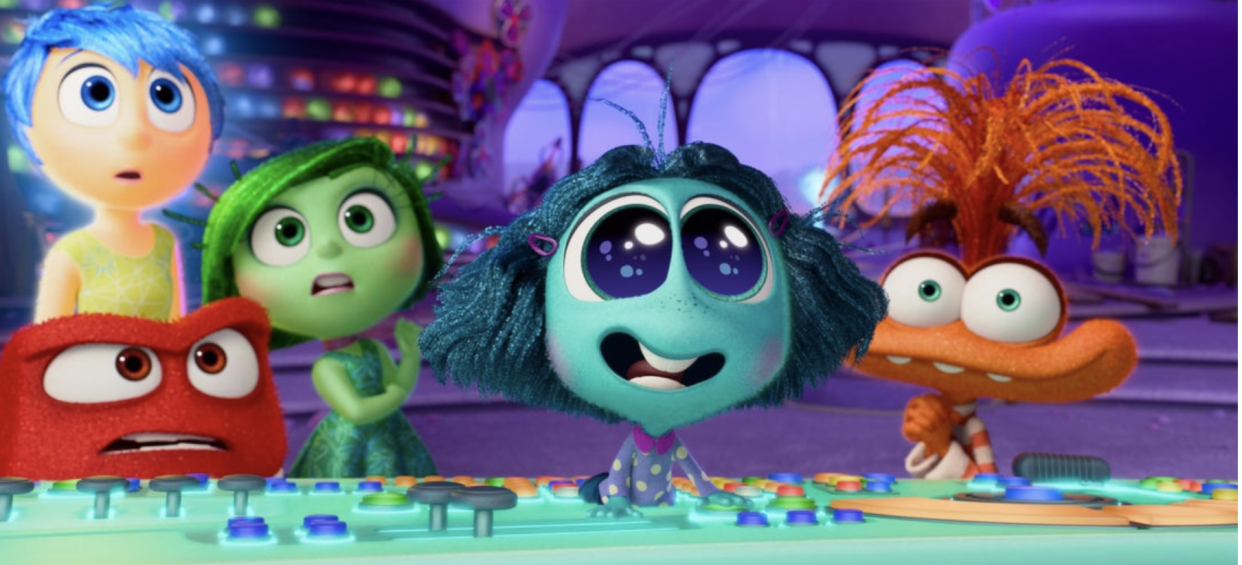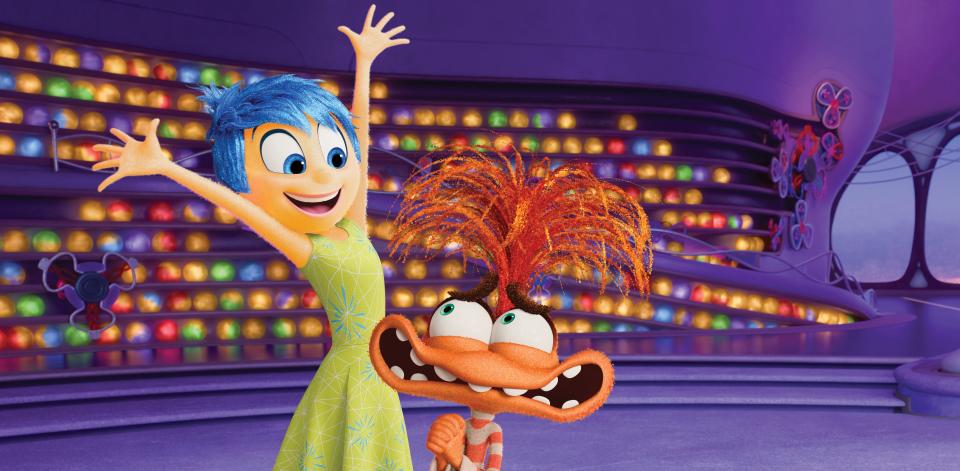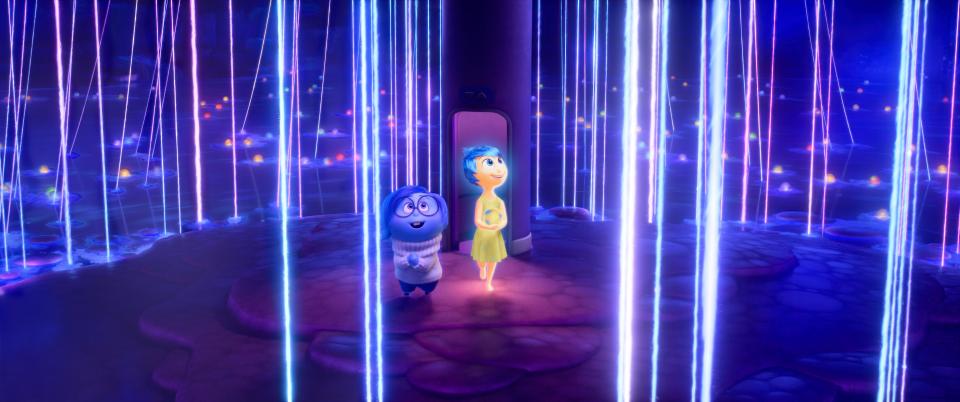‘Inside Out 2’ Review: All Brains and No Heart, This Disappointing Sequel Proves Pixar Learned All the Wrong Lessons from Its Pandemic Years

The pandemic couldn’t have come at a worse time for Pixar. The fading animation powerhouse emerged from a decade of creative misfires and middling sequels just to have two of their most personal films in forever — Enrico Casarosa’s “Luca” and Domee Shi’s “Turning Red” — dumped onto Disney+, further diluting the brand by retraining audiences to think of Pixar as just another content provider. “Lightyear” was supposed to be the silver bullet that got the studio back on track as the cartoon kings of the summer box office, but the ill-conceived “Toy Story” spinoff only confirmed that Luxo Jr. had lost his luster. Meanwhile, last year’s equally unsatisfying “Elemental” stumbled out of the gate in a way that took the shine off its slow-burn commercial success.
Faced with its first bonafide identity crisis, Pixar decided it would pivot away from original visions in favor of slam-dunk sequels, and deprioritize autobiographical stories in favor of returning to the high-concept universality that once made the studio a household name. Less “my coming-of-age as a second-generation immigrant in Toronto,” more “what if toys could talk?” As Bloomberg described this new strategy in a cognitively dissonant profile that found Pixar executives like chief creative officer Pete Docter framing mass appeal as a means to an end: “The studio’s movies should be less a pursuit of any director’s catharsis and instead speak to a commonality of experience.”
More from IndieWire
And so we arrive at “Inside Out 2,” which so perfectly ticks Pixar’s boxes in a way that forces the sincerity of its storytelling into a losing battle with the cynicism of its existence. It’s full of Joy, light on fun, and overstuffed with a mess of other emotions the film ingeniously personifies without ever really bringing them to life. Kelsey Mann’s feature debut is not only a sequel to director Docter’s 2015 mega-hit that felt like the “most Pixar” movie of its decade (for better or worse), but “Inside Out 2” also allows the studio to revisit the rare premise so universal that almost every person on Earth can see themselves in it without squinting: What if your brain was an office where all your emotions were forced to work together?
Pixar has always had a very American fetish for corporatizing the shared corners of our imagination (see: “Monsters, Inc.,” “Soul,” and the “Cars” series), but “Inside Out” went so far as to suggest that each of us is a standalone franchise of the human species, our minds an executive boardroom overseeing various subdivisions like memory and personality traits. Another studio might have seized the chance to depict people as Evangelion-like giants piloted by five competing emotions, but Pixar was more interested in literalizing our mental processes to explain young people to themselves, a goal achieved by thinking of the movie’s 11-year-old heroine as a theme park company held together by pneumatic tubes and organized around kid-friendly principles like vertical integration.
Endlessly colorful for a movie that mostly takes place in grey matter, “Inside Out” offered audiences such cleverly empirical displays of self-recognition (“that is how my core memories work!”) that most people were unbothered by the oppressiveness of a plot indistinguishable from its meaning. Its synopsis sounded like something a school counselor might say to assuage the film’s emotionally fraught sixth grader: “As you start to get older, Joy will have to work together with Sadness in order to make sense of a world that can no longer be navigated by just one feeling at a time.”
In spite of Docter’s ultra-prescriptive approach, however, there was an undeniable poignancy to how “Inside Out” rendered growing up as its own form of grief, each new excitement forcing us to leave something irreplaceably precious behind. And yet, relying on a handful of generic emotions to dramatize that process often made the movie seem more like a troubleshooting manual than a work of art. It was a staggering feat of imagination that left almost no room for our own; the only emotions it allowed us to feel were the ones shown onscreen.
Shorn of any real specificity beyond the fact that Riley loves the great sport of hockey (and that, unlike most 11-year-olds, her internal monologue is entirely voiced by famous television actors), “Inside Out” so relentlessly pursued a “commonality of experience” that it created a universal feedback loop. And Pixar, having learned all the wrong lessons from its ups and downs as a studio, couldn’t be happier to release a sequel twice as complicated, half as illuminating, and just as determined to reduce the extraordinary chaos of being a person into a one-size-fits-all explainer.

Of course, there’s nothing wrong with making smart and vibrant movies that might help kids better understand themselves and empathize with each other. The value of doing so would only seem to scale up as those kids age into teenagers like the now 13-year-old Riley, whose entire world is turned upside down by the sudden onset of puberty and the messy social fabric of starting high school. But if “Inside Out 2” finds a number of clever and faintly amusing ways to accommodate the influx of new emotions that erupt inside Riley’s brain during a summer weekend at hockey camp, the film’s conceit is too rigid and geared toward children to mature at the same pace.
Teens might need this sequel more than younger children needed the original, but I suspect the franchise’s unyielding didacticism won’t have the same effect for hormone-mad pimple-poppers whose physiology constantly makes them feel like history’s first and only freak (nothing resonates with 13-year-olds like a textbook!). It doesn’t help that the film’s basic plot — Joy is exiled from Headquarters along with some other emotions, and they all must make their way back to help Riley navigate some major life changes — is essentially just a redux of the story from “Inside Out.” After the previous movie made such a fuss about leaving childish things behind, it’s bizarre this one is so eager to retrace its footsteps.
The best explanation offered by Dave Holstein and Meg LeFauve’s script is that Joy still clings to an outdated sense of who “the real” Riley is (she’s sparked by another spirited performance from Amy Poehler, the “Parks and Recreation” star doing her best to texture a character who’s hopelessly one-note by definition). The manic-pixie-dream feeling has begrudgingly gotten used to sharing the girl’s mind console with her fellow emotions. But if Riley’s brain can be thought of like a hockey team — and “Inside Out 2” will not stop until you accept that it can — Joy is very much the captain.
While the other emotions are happy to clock in, do their jobs, and let the chips fall where they may, Joy is busy working the refs in order to protect Riley’s system of beliefs and her sense of self (two of many abstract concepts made thuddingly literal over the course of a film that fails to develop either beyond “I’m a good person”). Whenever a bad thought pops into Riley’s head, Joy sends it to the back of her mind before anyone else can notice — a minor penalty that will eventually have major repercussions.

Unbeknownst to Joy, she’ll have to work overtime to keep the bad thoughts at bay when Riley and her two best friends earn coveted invitations to a hockey camp run by the coach of the local high school (Yvette Nicole Brown). Already overeager to impress the team’s super cool star player and make a good impression on her potential future linemates, Riley (Kensington Tallman) isn’t in the best state of mind to learn that her BFFs will actually be going to a different school in the fall. The mental gymnastics required to get in with the older girls, dazzle their coach, and enjoy a last hurrah with Grace and Bree are enough to trigger a wave of new emotions in Riley’s brain, all of whom have their own basic schtick.
Embarrassment (a near-silent Paul Walter Hauser) is a big galoof who hides in his hoodie whenever anyone acknowledges him, an obvious bit the script returns to a half-dozen times in the hopes it might spontaneously become funny. Envy (a high-energy Ayo Edebiri) is a cyan little toadstool let down by a nice movie that never lets her go all the way green. Like Nostalgia (the great June Squibb) and Ennui (who’s voiced by a very amusing, very French Adèle Exarchopoulos, and is so blasé about everything that she operates the console from her phone on the couch), these new emotions are glorified cameos whose job is to overwhelm Riley and distract us from how the returning emotions haven’t really evolved since we last saw Riley. In lieu of fresh material, Fear and Disgust have recast voices (Tony Hale and Liza Lapira), while Anger and Sadness (Lewis Black and Phyllis Smith) are the same as you remember.
The only new emotion who actually matters to the story is Anxiety (Maya Hawke), the breakout star of any good adolescence. A bright orange tweaker whose feathery hair and mile-wide mouth of chattering teeth make her look like an ADHD-addled cross between Arnold from “Hey Arnold!” and Cher Horowitz’s pen, Anxiety is the great invention of “Inside Out 2,” and the biggest reason why this sequel is ultimately able to be a bit more sophisticated than the original. Of all the new emotions introduced, Anxiety is the only one legitimately explored rather than just cleverly defined, and Hawke’s frazzled performance does a fantastic job of personifying a quasi-antagonistic feeling that wants the best for Riley but will ruin her life if allowed to take over. Like Sadness, Joy will have to learn how to make room for Anxiety. But Anxiety isn’t quite so passive, and it sends Joy to the back of Riley’s mind so that it can create new beliefs like “If I’m good enough at hockey, I’ll have friends.” These movies might struggle to dramatize our brains, but they certainly understand how they work.
The journey back to Headquarters is a been there, done that slog with far too much in common with the first “Inside Out” in both form and function. Once again, the main emotions provide all the energy but little of anything else, as the heart and humor of this all-too-brainy sequel are delegated to the other bits of mental detritus that Joy and the gang encounter on their way back to the center of Riley’s head.
“Inside Out 2” has the advantage of recognizing that Bing Bong was everyone’s favorite aspect of the original, and so — to its benefit — it doubles down by having the emotions make a pitstop in Riley’s deepest secrets. That’s where they meet characters like Yong Yea’s Lance Slashblade (a stilted, PlayStation 2-grade video game hero who can only move in the directions on a D-pad), Ron Funches’ note-perfect Bloofy (a Barney knockoff whom Riley loved as a preschooler), and our new lord and savior Pouchy, a bottomless fanny pack full of dynamite (and voiced by “SNL” mega-talent James Austin Johnson). Brilliantly animated and freed from the burden of tear-jerking the adult members of the audience to death, these peripheral characters are a lot more fun than Bing Bong ever was. Still, it’s hard to ignore how the best parts of both “Inside Out” movies are things Riley has forgotten.
That’s more of a problem in this (ostensibly) more adult sequel, whose message about the evolving role that joy plays in our lives — and how beautiful it can be to balance our emotions as we get older — is undercut by a movie where all the stuff Riley has outgrown is just better and more identifiably human than so much of what’s meant to replace it. It wouldn’t serve her very well in high school, but Riley would be a more enjoyable character if her entire personality was just Anxiety and Pouchy.
But Pixar has decided that it can’t afford to make Riley unique, or to let her deviate from the studio’s concept sketch of a “good” 13-year-old girl in any way. For all the brilliance of its design, no Pixar movie has ever provoked so little sense of wonder (say what you will about Larry the Cable Guy voicing a buck-toothed tow-truck, but at least it leaves you with some urgent questions about the world). For all the creativity of its construction, “Inside Out 2” feels like a form of AI cinema, happy to animate human thoughts but incapable of thinking for itself.
Here we have another spreadsheet of a movie that conceives of the human mind with the vision of a digital artist and the ethos of a corporate accountant; a film so mercilessly “relatable” that only a chatbot could ever hope to see themselves in it. It’s a story about the universal chaos of adolescence told by a studio that once prided itself on being original, but now — after suffering a little public embarrassment — shares every teenager’s mortal fear of being different. Like Riley, Pixar seems determined to forget what made it so special in the first place. Here’s hoping that “Inside Out 3” leaves plenty of room for Regret.
Grade: C-
Walt Disney Pictures will release “Inside Out 2” in theaters on Friday, June 14.
Best of IndieWire
Sign up for Indiewire's Newsletter. For the latest news, follow us on Facebook, Twitter, and Instagram.
